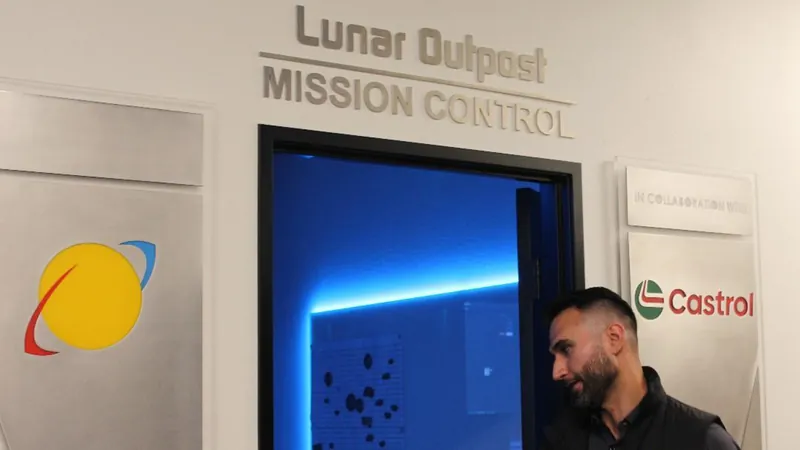
Unveiling Lunar Outpost's Moon Rover Mission Control: Are We Ready to Roll on the Moon?
2025-09-15
Author: Ling
Lunar Outpost's Groundbreaking Mission Control Revealed
In the heart of Arvada, Colorado, Lunar Outpost, an innovative private space company, is revving up its lunar terrain vehicle (LTV), an advanced rover proposed for NASA’s Artemis astronauts to navigate the moon's rugged, crater-filled surface.
The Engineering Marvel: Meet the 'Eagle'
A recent tour of Lunar Outpost's Mission Control offered an exclusive glimpse into the development of the LTV dubbed the 'Eagle.' CEO and co-founder Justin Cyrus described the design as a brilliant fusion of a dune buggy's agility and a heavy-duty truck's durability.
In collaboration with industry giants like General Motors and Goodyear, Lunar Outpost is one of three teams selected by NASA for a one-year feasibility study, with the announcement of the final LTV contract expected by the year's end.
Trial and Triumph: Testing the Waters
Excitingly, the company has already tested its technology in the form of a Mobile Autonomous Prospecting Platform (MAPP) rover, which was included in the payload of Intuitive Machine's Athena lunar lander. While Athena's unfortunate landing mishap on March 6, 2025, prevented MAPP from conducting surface exploration, crucial data was still collected from the lunar environment.
Mission Control: High-Tech and Cozy!
Lunar Outpost's Mission Control is not just functional; it’s cozy and tech-savvy. The state-of-the-art facility is equipped with high-definition screens and dynamic lighting that changes based on operational needs. A bright red hue signals a crisis, while other colors represent various operational modes.
The Lunar Outpost Test Facility: A Cratered Wonderland
The nearby Autonomous Test Facility in Rye, Colorado, is a testing paradise, landscaped with simulated craters and rocks. This site allows for extensive trials of the LTV, either autonomously or under human supervision, ensuring readiness for the challenges of the lunar landscape.
Adaptive Operations: Modes of Exploration
The Eagle is engineered to traverse the moon in multiple operational modes, whether driven by astronauts, autonomously operating without intervention, or controlled from Mission Control back on Earth. With a top speed of 25 miles per hour, it promises efficiency while remaining cautious of the moon's hazardous terrain.
Moon Maintenance Made Easy
Equipped with a robotic arm capable of tasks like cleaning solar panels and repairing landing pads, the LTV allows astronauts to focus on high-value scientific missions, thus maximizing valuable exploration time.
Astronaut Insights Transform the Design
Remarkably, astronaut feedback has heavily influenced the design of the LTV. Guidance on stair height, knee clearance, and handles have been incorporated, all aimed at accommodating the unique challenges of operation in spacesuits.
Ready for the Moon: Thermal Challenges Ahead
Operating on the lunar surface requires innovative thermal management, especially in Permanently Shadowed Regions (PSRs). Cyrus reassured that Lunar Outpost is advancing technologies enabling substantial operational time in these ice-rich areas, crucial for future lunar habitation.
The Future of Lunar Mobility Is Here
With significant investments in testing and risk reduction, Lunar Outpost is poised for success, declaring, "We are ready to drive!" As exploration expands beyond Earth, the mission to secure safe and efficient lunar mobility is just getting started.





 Brasil (PT)
Brasil (PT)
 Canada (EN)
Canada (EN)
 Chile (ES)
Chile (ES)
 Česko (CS)
Česko (CS)
 대한민국 (KO)
대한민국 (KO)
 España (ES)
España (ES)
 France (FR)
France (FR)
 Hong Kong (EN)
Hong Kong (EN)
 Italia (IT)
Italia (IT)
 日本 (JA)
日本 (JA)
 Magyarország (HU)
Magyarország (HU)
 Norge (NO)
Norge (NO)
 Polska (PL)
Polska (PL)
 Schweiz (DE)
Schweiz (DE)
 Singapore (EN)
Singapore (EN)
 Sverige (SV)
Sverige (SV)
 Suomi (FI)
Suomi (FI)
 Türkiye (TR)
Türkiye (TR)
 الإمارات العربية المتحدة (AR)
الإمارات العربية المتحدة (AR)